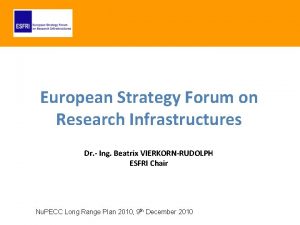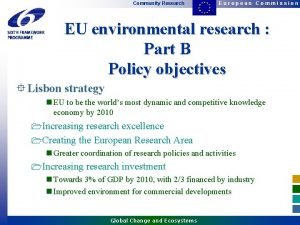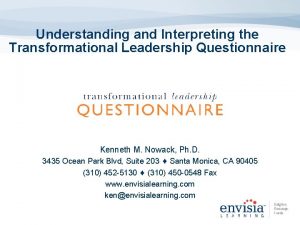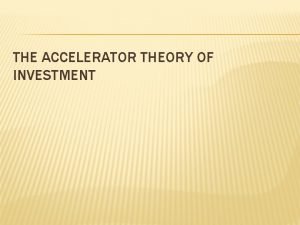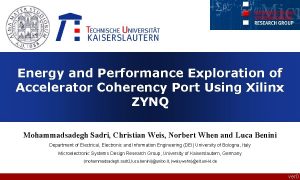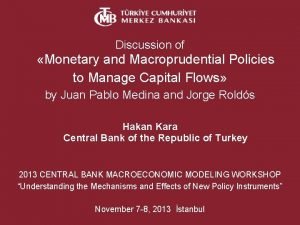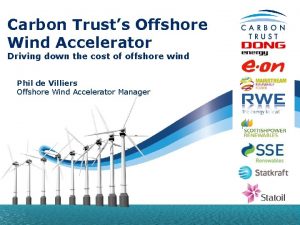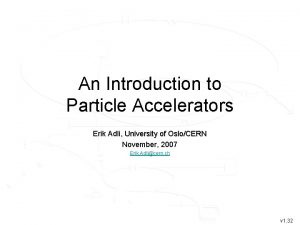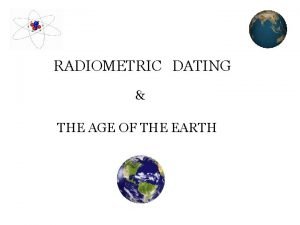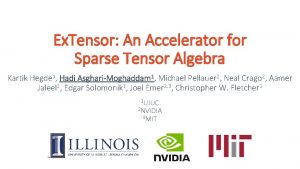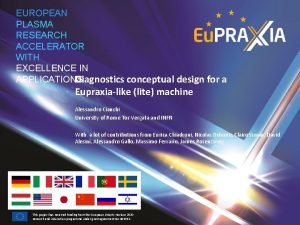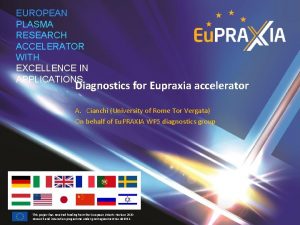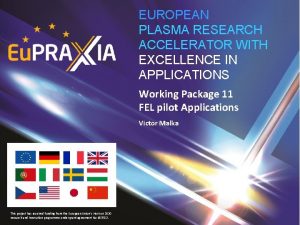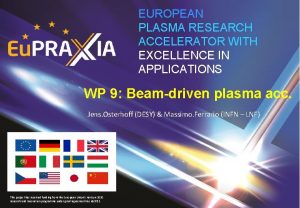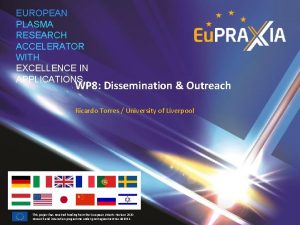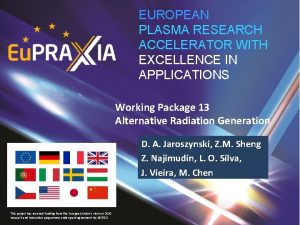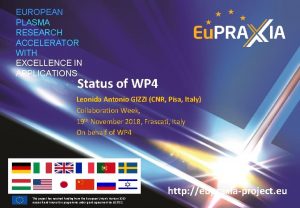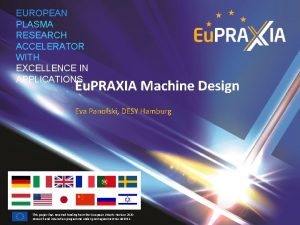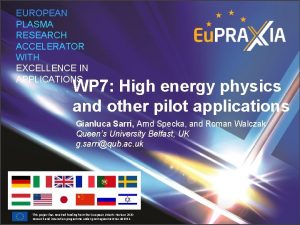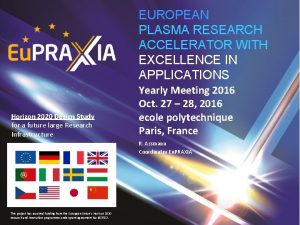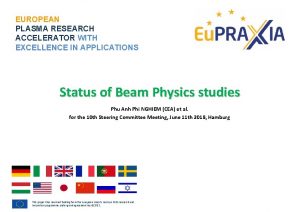EUROPEAN PLASMA RESEARCH ACCELERATOR WITH EXCELLENCE IN APPLICATIONS
















- Slides: 16

EUROPEAN PLASMA RESEARCH ACCELERATOR WITH EXCELLENCE IN APPLICATIONS Status of WP 4 Leonida Antonio GIZZI (CNR, Pisa, Italy) Collaboration Week, 4 th July 2018, Liverpool On behalf of WP 4 This project has received funding from the European Union’s Horizon 2020 research and innovation programme under grant agreement No 653782. http: //eupraxia-project. eu

Contributors CNR – Italy Leonida A. GIZZI, Istituto Nazionale di Ottica-CNR, Pisa Petra KOESTER INO-CNR, (Eu. PRAXIA contract), Pisa Luca LABATE, INO-CNR, Pisa Fernando BRANDI, INO-CNR, Pisa Gian Carlo BUSSOLINO, INO-CNR, Pisa Barbara PATRIZI, INO-CNR, Firenze Guido TOCI, INO-CNR, Firenze Matteo VANNINI, INO-CNR, Firenze Horizon 2020 CNRS – France François MATHIEU, CNRS, Ecole Polytechnique Zeudi MAZZOTTA, CNRS, Ecole Polytechnique (Eupraxia contract) Dimitrios PAPADOPOULOS, CNRS, Ecole Polytechnique Catherine LE BLANC, CNRS, Ecole Polytechnique Bruno LE GARREC, CNRS, Ecole Polytechnique Audrey BELUZE, CNRS, Ecole Polytechnique Jean-Luc PAILLARD, CNRS, Ecole Polytechnique Collaborators Franck FALCOZ Amplitude Technologies Christophe SIMON BOISSON Sandrine RICAUD Sebastien LAUX Thales Group industries laboratories shaded major contributors/collaborators Rajeev PATTATHIL Klaus ERTEL Paul MASON Marco GALIMBERTI STFC Rutherford Appleton Laboratory Oliver KARGER Andy BAYRAMIAN Alexander KNETSCH Constantin HAEFNER Craig W. SIDERS Lawrence Tom SPINKA Livermore National Maria Pia ANANIA K. CHESTNUT Fabrizio BISESTO Laboratory E. ERLANDSON Dario GIOVE T. GALVIN M. BELLAVEGLIA K. SHAFFERS E. SISTRUNK S. GALLO Hamburg University INFN LNF 2

CONTENT Horizon 2020 • Main Eu. PRAXIA laser features • Needed key developments • Next phase • Conclusions 3

Eu. PRAXIA Laser Layout Horizon 2020 The current Eu. PRAXIA laser design 1 relies on mature Titanium Sapphire industrial technology to deliver average and peak power as required by the project. A set of three laser chains are considered, to drive the injectors at 150 Me. V and MAIN CHALLENGES 1 Ge. V, and the accelerator at 5 Ge. V. • Pumping technology: • High rep. rate, high energy Gain media: Bandwidth, Size, Thermal load, Cooling • Grating technology Size, LIDT, Thermal load, Cooling • • Pointing stability Transport L. A. Gizzi et al. , A viable laser driver for a user plasma accelerator. , NIM-A, (2018). 4

Candidate pump energy sources Horizon 2020 Promising developments based on diode pumping technology are in progress at Eu. PRAXIA industrial and research partners, progressively matching requirements Amplitude P 60 Flashlamp pumped Nd: YAG Design: 60 J @ 10 Hz, 532 nm Conversion to DPSS fully designed • • Expected rep. rate 50 Hz Cost of diode still an issue – currently 5 x compared to flashlamps. Expected to decrease in 5 -10 yrs. Maintenance free operation for 25 -30 yrs. DIPOLE(2) 100 DPSSL cryogenic HE cooling system 100 J @ 10 Hz, @515 nm 2)P. Planned developments: 10 J @ 100 Mason et al. , Kilowatt average Hzpower 100 J-level diode pumped solid state laser, " Optica 4, 438 -439 (2017) 5

100 Hz pump laser Horizon 2020 White paper 100 Hz pump trials to assist Eu. PRAXIA system design (STFC, LLNL, HZDR, FBH), supported by the Institute of Quantum Optics, Friedrich-Schiller-University, Jena in Germany

Laser design - Amplifiers Main recent activities Definition of pump sources arrays for the various amplification stages, based on available (SCLF Di. POLE / Amplitude P 60) and perspective technologies Design of amplifier stages layout (both for transmission and reflection amplifiers); evaluation of required footprint. Pump delivery /timing schemes for Extraction During Pumping Optimization/simplification of amplifier design (reduction of number of stages/passes) and trade-off on thermal design *) Water cooled Ti: Sa amplifier under development at ELI-HU (After V. Cvhykov et al. , Opt. Lett, 41, 3017, 2016) **) Fluid (D 2 O ) cooled Nd: YAG laser, 20 k. W CW pump power, D 2 O (After X. Fu et al. , Opt. Express, 22, 18421 (2014) ***) Fluid (Siloxane ) cooled Nd: YLF laser, 5 k. W CW pump power (After Z. Ye et al. , Opt. Express, 24, 1758 (2016) Horizon 2020

Transport to target Main challenges: large optics, mechanical stability, cooling of gratings, beam quality control … Horizon 2020

Compressor: grating technology Horizon 2020 Different technologies under evaluation to address main issues with higher repetition rate. Strategy includes reduction of thermal load at high average power, cooling of residual heat and control of thermal effects on compression quality.

Summary on developments • • Horizon 2020 Prototyping of Ti: Sa amplifiers Addressing 100 Hz pump lasers developments Thermal management of compressor gratings Stability (pointing & more) and active control Driver pulse temporal shaping and synchronization Construction Integration Issues … Please fill in excel file (Ralph’s message on 28 June) if you can contribute to these items. 10

SAC Recommendation Horizon 2020 Rec 12. Broaden the dialogue to other WPs (e. g. WP 2, WP 5, WP 14) to inform on design space, specifically on critical parameters (e. g. a 0 vs power/focal area). Effective interaction with WP 2/3 Rec 13. Explore feasibility of timing precision and jitter requirements provided by WP 2 and WP 3, and how it can be verified at the target. Work in progress at Desy Rec 14. Develop a better understanding of pointing requirements and metrics, specifically how they are coupled to the facility. Building DB of pointing performance at facilities Rec 15. Develop a strategic technology roadmap that supports the overarching performance goals of Eu. PRAXIA. Get guidance on technology demonstrator vs science facility. Maintain perspective of technologies that can scale. Work in progress – requires additional funding Rec 16. Given the timescales on how much technology development is required, how long does it take, and when construction of a system could start, identify risk reduction experiments that add credibility to the feasibility of certain technologies. Experiments identified Rec 17. Develop a crisp risk matrix for each technology approach, identify bottlenecks and areas where risk reduction experiments are needed. Identify synergetic efforts between technology paths. Set of bottlenecks identified and being explored Rec 18. Use technical readiness levels for the integrated laser system concepts (not individual components) to assess and compare maturity of each solution. In progress in collaboration with industry 11

PROJECT DELIVERABLES D 4. 1 (M 12) Benchmarking of existing technologies D requirements E and comparison with Eu. Praxia R E V I EL D Explore and identify promising technologies D 4. 2 (M 24) Preliminary laser design D E R IVEeye to perspective To be developed with. ELan D industrial development D 4. 3 (M 24) Preliminary design of transverse functions VERED I L E To account for final Duse of Eu. PRAXIA (user facility) Horizon 2020

PROJECT DELIVERABLES D 4. 4 (M 36) Final requirements of laser system To comfortably accommodate LWFA design and other laser based activities D 4. 5 (M 36) Control command design system To enable turn-key-like operation of the laser system Horizon 2020

LABs AND INDUSTRY Horizon 2020 A wide collaboration is ready to be involved to tackle open issues Lawrence Livermore Natl. Lab and many more

SUMMARY Horizon 2020 • Eu. PRAXIA aiming at PW-k. W laser system driver, well beyond current state-of-the-art; • Design phase ongoing: preliminary design going technical; • Also considering evolution towards higher repetition rate; • Significant development activities and funding needed to solve standing technical issues; • Now collecting proposals from contributing groups for next phase. 15

Consortium Horizon 2020 16 Participants 22 Associated Partners (as of October 2016) 16
 Eden european destinations of excellence
Eden european destinations of excellence Abu dhabi award for research excellence (aare)
Abu dhabi award for research excellence (aare) European strategy forum on research infrastructures
European strategy forum on research infrastructures European commission community research
European commission community research Grasp model
Grasp model Criticism of accelerator theory of investment
Criticism of accelerator theory of investment Biztalk swift
Biztalk swift Accelerator forced rescan
Accelerator forced rescan Fiscal policy ib
Fiscal policy ib Accelerator coherency port
Accelerator coherency port Financial accelerator
Financial accelerator Offshore wind accelerator
Offshore wind accelerator Particle accelerator formula
Particle accelerator formula Vm backup best practices
Vm backup best practices Dating
Dating Open capi
Open capi Extensor: an accelerator for sparse tensor algebra
Extensor: an accelerator for sparse tensor algebra


